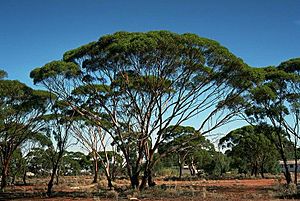Eucalyptus myriadena facts for kids
Quick facts for kids Eucalyptus myriadena |
|
|---|---|
 |
|
| Eucalyptus myriadena near Southern Cross | |
| Scientific classification | |
| Genus: |
Eucalyptus
|
| Species: |
myriadena
|
The Eucalyptus myriadena, often called the blackbutt, is a unique mallee or tree that grows naturally in Western Australia. It has rough, flaky bark on the lower part of its trunk, but smooth bark higher up. Its leaves are long and narrow, and its white flowers grow in groups of nine to thirteen. This tree is common in the wheatbelt and goldfield areas of the state.
Contents
What Does the Blackbutt Look Like?
The Eucalyptus myriadena is a mallee or tree that usually grows to be about 3 to 12 meters (10 to 39 feet) tall. It has a special woody swelling at its base called a lignotuber, which helps it regrow after fires.
About half of the lower trunk has rough, flaky bark. Above this, the bark is smooth and can be bronze-grey or coppery in color.
Its adult leaves are arranged one after another along the stem. They are long and narrow, like a spear, and are a very shiny green on both sides. These leaves are typically 50 to 100 millimeters (2 to 4 inches) long and 6 to 12 millimeters (0.2 to 0.5 inches) wide. They narrow down to a small stalk called a petiole, which is about 5 to 10 millimeters (0.2 to 0.4 inches) long. The leaves also have a finely pointed tip. If you look closely, you can often see the side veins, but many tiny oil glands hide the other veins.
The flower buds grow in groups of nine to thirteen on a stem called a peduncle, which is 5 to 14 millimeters (0.2 to 0.6 inches) long. Each individual bud sits on a tiny stalk called a pedicel, about 1 to 4 millimeters (0.04 to 0.2 inches) long. When the buds are ready, they are narrow and shaped like a cylinder, about 3 to 7 millimeters (0.1 to 0.3 inches) long and 1.5 to 3 millimeters (0.06 to 0.1 inches) wide. They have a cone-shaped or rounded cap called an operculum.
The blackbutt blooms with white flowers between November and April. After flowering, it produces a woody fruit called a capsule. This fruit is narrow and shaped like a cylinder or barrel, about 3 to 6 millimeters (0.1 to 0.2 inches) long and 3 to 4 millimeters (0.1 to 0.2 inches) wide. The parts that open to release seeds are tucked inside the rim. The seeds are pale golden-brown, flat, and oval-shaped, measuring about 0.5 to 1.3 millimeters (0.02 to 0.05 inches) long.
Its Name and Family
This plant was first officially described by a botanist named Ian Brooker in 1981. He published his description in a science journal called Brunonia.
The second part of its scientific name, myriadena, comes from two Greek words. Myri- means 'many', and adena means 'glands'. This name was chosen because the plant's leaves have a very high number of oil glands.
In 1993, Ian Brooker also described two slightly different types of Eucalyptus myriadena, which are called subspecies. These names are now accepted by plant experts in Australia.
- Eucalyptus myriadena subsp. myriadena
- Eucalyptus myriadena subsp. parviflora was named by Brooker and Stephen Hopper. This subspecies is different because it has smaller buds and fruit.
Where Does the Blackbutt Grow?
This type of eucalypt is found in Western Australia. It grows on flat lands, low hills, and around clay flats, salt lakes, and swamps. You can find it in the Mid West, Wheatbelt, and Goldfields-Esperance regions. It prefers gravelly sandy-clay-loam soils. Its scattered range stretches from Coorow in the northwest to Ravensthorpe in the south, and as far east as Coolgardie.
The Eucalyptus myriadena is part of open woodland areas. It grows alongside other trees and mallees, such as the salmon gum (E. salmonophloia) and the York gum (E. loxophleba). The plants growing underneath these trees can vary, but often include saltbushes like Rhagodia drummondii and Atriplex vesicaria, and other shrubs like Scaevola spinescens and the mallee honeymyrtle (Melaleuca acuminata).
How People Use It
The blackbutt tree can be bought as young plants or seeds from nurseries. It's a tough tree because it can handle drought (very dry conditions) and salty soils. This makes it useful for planting in areas where other trees might struggle.
It is also planted to harvest for its Eucalyptus oil. This oil is used in many products, from medicines to cleaning supplies.

